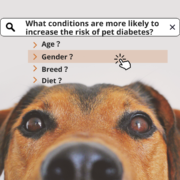What conditions are more likely to increase the risk of pet diabetes?
Did you know? Diabetes is a potential health threat to pets, and certain conditions can increase their risk of developing diabetes, including factors such as gender, age, and breed. Let’s take a closer look.
1. Breed:
- For dogs: Samoyed, Maltese, Schnauzer, etc.
- For cats: Burmese cats and larger breeds like Norwegian Forest Cats.
2. Obesity:
Insufficient physical activity or overeating in pets may lead to excessive body weight or obesity, which can result in reduced sensitivity of cells to insulin.
3. Diet:
Inappropriate diet may lead to cats overeating or excessive calorie intake, resulting in obesity;Feeding dogs excessive fat can potentially trigger issues such as pancreatitis.
4. Gender:
- For dogs: Unspayed female dogs are more susceptible to diabetes compared to male dogs.
- For cats: Male cats naturally have lower insulin sensitivity, making them more prone to diabetes compared to female cats.
5. Inflammation:
When dogs and cats experience an inflammatory response in their bodies, it can affect their insulin sensitivity and thereby increase the risk of diabetes.
6. Medication:
When dogs and cats are on medications that impact blood sugar over an extended period, using higher doses, for longer durations, or if they already belong to a high-risk group, it may lead to the development of diabetes.


While these factors may increase the risk of pets developing diabetes, they are not uncontrollable elements. Regular health check-ups, proper nutrition, exercise, and maintaining a healthy weight can all contribute to reducing the risk of diabetes. Remember, prevention is better than cure, so work closely with your veterinarian to ensure your beloved pet stays healthy and minimizes the risk of diabetes.




